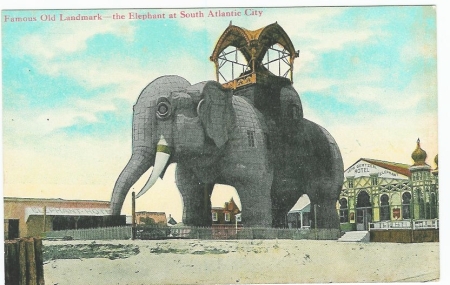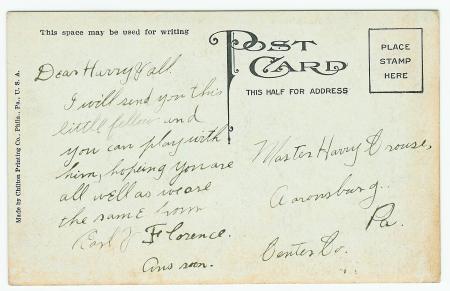Lucy the Elephant as pictured on three postcards, each from a different postcard era. The linen era postcard proclaims in the bottom border: THE ONLY ELEPHANT IN THE WORLD YOU CAN GO THROUGH AND COME OUT ALIVE. Lucy the Elephant (also known as the “Margate Elephant” or “Lucy the Margate Elephant”) was recently in the news; a tent that was blown from its moorings by high winds on September 11, 2009 gave Lucy a smack on her backside that broke her tail! Hmmm, do you call a vet or an architect? The 65-foot high wood and tin structure was struck by lightning (not for the first time) over the fourth of July weekend of 2011. Update of November 1, 2012: Lucy survived Hurricane Sandy intact, according to this news feature (includes aerial photo). Lucy the Elephant was the brain-child of James V. Lafferty, a land developer who wanted to attract attention to his 1880s South Atlantic City (New Jersey) development project. Two other mammoth elephant buildings were constructed around the same time: The Elephantine Colossus was a truly massive building in the Coney Island amusment park in Coney Island, New York. Over twice the size of Lucy the Elephant, if the Colossal Elephant could have lumbered into New York City and paraded to the intersection of Broadway and Fifth Avenue, it might have stood about a third or more the height of the Flatiron Building. The Elephantine Colossus, also known as the Elephant Hotel, succumbed to a devastating fire in 1896. A third elephant-shaped building, this one named The Light of Asia, was constructed at the site of another land development project, this one in South Cape May, New Jersy. Here is an excerpt from lighthousefriends.com entry for Cape May, New Jersey: “…the entire community of South Cape May fell victim to the encroaching waters of the Atlantic. A land developer named Theodore Reger purchased much of the shoreline between the lighthouse and the town of Cape May in 1882. Three years later, Reger had constructed a huge wooden and tin elephant, known as the Light of Asia, to attract interest in his development at South Cape May. For a dime, tourists could enter the elephant through its hind legs, climb a spiral staircase to a hall in its belly, and then proceed up a second set of stairs to the howdah or viewing platform on the elephant’s back. Several cottages were built in South Cape May, but erosion has wiped away almost all signs of human (and elephant) habitation, and the area is now the Cape May Migratory Bird Refuge managed by the Nature Conservancy.”
Thus, Lucy the Elephant is the sole survivor of a memory of elephants in architectural form.
This architectural quadruped has been submitted into the Festival of Postcards, coordinated by Evelyn Yvonne Theriault.
The sender has written on the back of the post card this message: “Dear Harry & all, I will send you this little fellow and you can play with him. Hoping you are all well as we are the same. From Earl V. Florence ans. soon.” The postcard is addressed to Master Harry Crouse, Aaronsburg, PA Center Co. Since the postcard has not been postally used (no postage stamp and thus no postmark), There are only three possibilities:: 1.) The postcard was hand delivered to Mr. Crouse, 2.) It card was enclosed in an envelope containing a letter from Mr. Florence to Mr. Crouse or another person in the Crouse household, or 3.) The postcard was never sent at all, so Harry Crouse would have never known of its existence. This postcard is an example of what I term a “self-referential” postcard, since the written message contains a reference to the subject matter depicted on the front of the postcard.
Tags: divided back era, Elephant Hotel, Elephantine Colossus, James V Lafferty, Light of Asia, linen era, Lucy the Elephant, Margate, Margate Elephant, South Atlantic City, undivided back era, vintage postcards, white border era




October 29, 2009 at 10:17 PM |
[…] And Leo’s second post ever (in this blog) is his entry in this month’s Festival – Lucy the elephant. I’m looking forward to all the “-ness” that Leo can […]
October 30, 2009 at 7:05 PM |
I love that you have cards from the three different times. It’s not always easy to do _ I’ve been trying to chart the changes in our local town and I’m not finding it so easy.
December 31, 2009 at 10:16 PM |
Thank you for your comment, Sheila! While sorting a batch of postcards, I noticed that there were three postcards of Lucy the Elephant, and when I grouped them together, it became obvious that each one represented a different postcard era.
Yes, it can be challenging to find postcards depicting the same or similar town view as the scene changes through time. If you would care to share what town you are researching, perhaps I or some other reader might have a view of the town that you don’t yet have in your collection. Good luck in your search! — Leo
December 1, 2009 at 12:38 PM |
Greetings!
If you would like to participate in the December Festival, you can find information here:
http://acanadianfamily.com/2009/11/17/a-festival-of-postcards-6th-ed-white-call-for-submissions/
January 10, 2010 at 2:04 AM |
Leo – Here’s another view of “Lucy” via the Washington Crossing Card Collectors Club. She appears on their page that asks (and then answers) the question “Why Collect Postcards?” http://www.wc4postcards.org/whycollect.html
January 10, 2010 at 11:15 PM |
Thank you, Susan, for the link to the Washington Crossing Card Collectors Club. In addition to the depiction of Lucy, the site offers lots of information about postcards and postcard collecting. Lucy was constructed in South Atlantic City, New Jersey, which later changed its name to Margate, New Jersey. The Margate Public Library maintains a website that has a page with images of eight different postcards of Lucy the Elephant, sometimes referred to as The Margate Elephant:
http://www.margatelibrary.org/librarianfavoritesdetail.asp?id=96
Although the reverses of the postcards are not shown, since the first two images of the Lucy postcards have space for a message to be written on the obverse, they would add a fourth postcard era (the undivided-back era) of Lucy postcards to the three eras represented in my post. If you ever see “UDB” in a postcard desription, it typically is an abbreviation of UnDivided Back. — Leo
November 22, 2013 at 4:47 AM |
[…] Elefannte Lucy Margate NJ Fuente: postcardiness […]